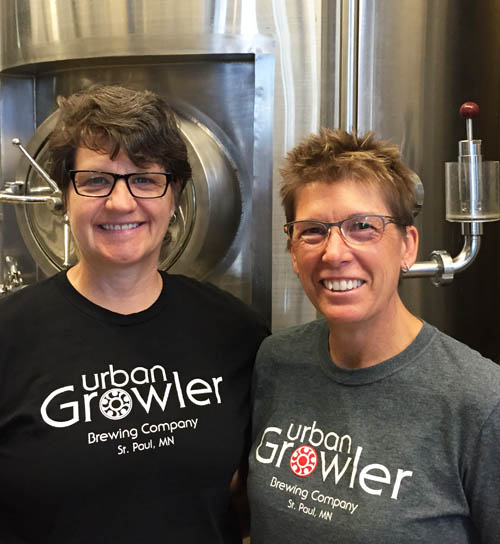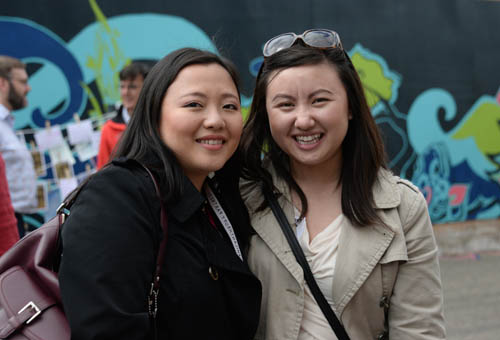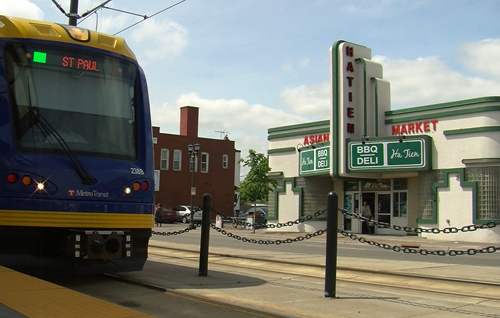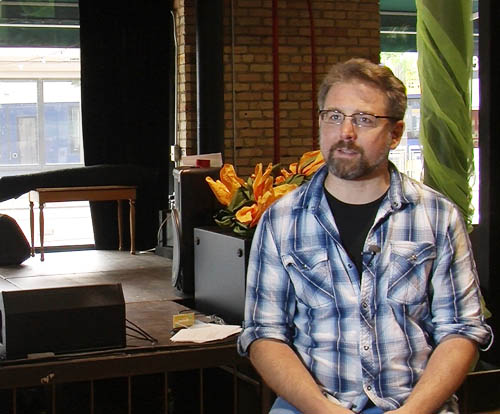When METRO Green Line service launched in June 2014, local leaders had great expectations for the service itself, as well as the community and economic growth it would attract.
Now one year old, the 11-mile light rail line carries about 1 million riders a month to the neighborhoods between the downtowns. And business owners say the Green Line also provides an essential connection for riders to discover and explore communities, businesses, and arts and cultural amenities along the corridor.
The experience that riders are having as they travel along the Green Line is a testament to the strength of the communities that call the neighborhoods along the line home.
“The success of the Green Line is about the foundations that saw ahead, the artists that got involved, the businesses that stuck with it through construction, and others that came together,” says John Francis Bueche, co-founder of the Bedlam Theater located near the Union Depot stop. “The story here is a story of the community coming together and saying ‘Let’s make this thing be what we want it to be.’”
LRT stations are focal point for development and cultural districts
 Since 2009, the year before Green Line construction started, the neighborhoods between the Downtown East station in Minneapolis and the Union Depot station in Saint Paul have experienced more than $3 billion in commercial and residential development – including new construction, redevelopment, and expansion. In addition, businesses on the corridor prior to the Green Line opening reinvested in their businesses and related community efforts to create distinctive districts around the stations.
Since 2009, the year before Green Line construction started, the neighborhoods between the Downtown East station in Minneapolis and the Union Depot station in Saint Paul have experienced more than $3 billion in commercial and residential development – including new construction, redevelopment, and expansion. In addition, businesses on the corridor prior to the Green Line opening reinvested in their businesses and related community efforts to create distinctive districts around the stations.
Local efforts such as the Creative Enterprise Zone and Historic Rondo in Saint Paul and the West Bank and Prospect Park 2020 initiatives in Minneapolis are using LRT stations as focal points for bringing together artists and business owners and reimagining buildings and spaces that before light rail had been vacant or went largely unnoticed.
Residents and visitors congregate for events in Little Mekong
Va Megn Thoj and the team at the Asian Economic Development Association (AEDA) have been leading efforts to establish Little Mekong, a district of businesses largely owned by Asian entrepreneurs centered near the Western Avenue Station.
 At a recent Little Mekong event, visitors to what is normally a wide barren parking lot congregated at large tables to dine on savory noodles and listen to rhythmic drumming. It’s just one of the events that highlight Little Mekong as a destination, says Thoj.
At a recent Little Mekong event, visitors to what is normally a wide barren parking lot congregated at large tables to dine on savory noodles and listen to rhythmic drumming. It’s just one of the events that highlight Little Mekong as a destination, says Thoj.
“Ultimately, Little Mekong is about supporting the businesses and neighborhoods in the area,” Thoj says. “We feel that by attracting small businesses and helping them grow, we’ll attract new investment and help preserve the community we have and build on the assets in our community. We’re working with businesses to help them think about how to take advantage of the light rail.”
AEDA also organizes the Little Mekong Night Market, a periodic event that takes place in the parking lot behind a building shared by Hmong American Partnership and Mai Village restaurant.
“We promote our night market as a community event that allows people to immerse themselves in the neighborhood,” Thoj says. “We encourage people to use the Green Line to come to the event.”
Businesses reinvest and thrive along the Green Line
Thoj has seen the new and existing businesses on University Avenue that he and his team work with begin to reap the rewards of investments they made to take advantage of their proximity to light rail.
 He pointed to the example of a community health clinic that moved into a building that had been vacant for some time. “They came to us saying that they wanted to open on University Avenue because of the Green Line,” Thoj says. “They felt the light rail would provide good access for their patients.”
He pointed to the example of a community health clinic that moved into a building that had been vacant for some time. “They came to us saying that they wanted to open on University Avenue because of the Green Line,” Thoj says. “They felt the light rail would provide good access for their patients.”
Thoj also shared the story of Ha Tien, a well established grocery store and deli on University Avenue. “Like many businesses they started concerned about how they would survive construction. In the end, they thought that ‘instead of worrying, how can we take advantage of the fact that light rail is coming?’”
Thoj says Ha Tien invested more than $800,000 into improving the storefront and updating equipment while the light rail was under construction. According to Thoj, Ha Tien’s business has increased by 40% and owners hired new staff in the past year.
Connecting the arts community
Alongside new entrepreneurs and established business owners, creative talents from a wide variety of disciplines have a significant presence along the Green Line – whether through community-led efforts such as the Creative Enterprise Zone or West Bank arts scene, new and existing theater venues, or breathing new life into legacy neighborhood music venues like the Turf Club.
 Within a 10-minute walk of stations along the line, theater and music lovers can reach any of more than 20 performing arts venues, from the historic stages on Hennepin Avenue in Minneapolis to the newly renovated Ordway and the new Bedlam Theater in Saint Paul. Altogether, these spaces offer more 20,000 seats with options ranging from drama, comedy, classical music, and Broadway hits, as well as performances featuring local musicians and original productions.
Within a 10-minute walk of stations along the line, theater and music lovers can reach any of more than 20 performing arts venues, from the historic stages on Hennepin Avenue in Minneapolis to the newly renovated Ordway and the new Bedlam Theater in Saint Paul. Altogether, these spaces offer more 20,000 seats with options ranging from drama, comedy, classical music, and Broadway hits, as well as performances featuring local musicians and original productions.
In 2012, Bedlam relocated its performance space from the Cedar-Riverside neighborhood to Lowertown after its Minneapolis building was purchased by a new owner.
Bedlam started holding performances and hosting events in its new space in fall 2014. In its first seven months of operation, according to Bueche, the theater has showcased more than 100 live music shows in additional to live theater and dance productions produced by Bedlam’s own staff.
For Bueche, the Green Line keeps his staff connected to each other, and to their former home.
“At the end of the night, we’ll bring our bikes onto the train and talk about the day while we ride back to Minneapolis,” Bueche said. “Something about the Green Line makes [Cedar Riverside] feel closer, even though it’s not any closer than it ever was. It’s great with the Mixed Blood and the Southern Theater right there at the West Bank stop.”
Art gallery sees boom in traffic
 Other types of arts-based business are seeing a boost from the Green Line, as well. Dow Art Gallery and Picture Framing on University Avenue is a four-minute walk from the Raymond Avenue Station. Dow features a rolling selection of artwork from more than 40 local artists, as well as custom framing.
Other types of arts-based business are seeing a boost from the Green Line, as well. Dow Art Gallery and Picture Framing on University Avenue is a four-minute walk from the Raymond Avenue Station. Dow features a rolling selection of artwork from more than 40 local artists, as well as custom framing.
“Since September of last year, I’ve had a show every month and every month we’ve seen more and more people,” says gallery owner Khahn Tran.
Tran says the biggest boost yet came this past spring when he participated in the Saint Paul Art Crawl. The Art Crawl partnered with Metro Transit to offer passes for free transit rides that attendees download and print from the event website, which drew more than 1,500 visitors, compared to a typical show, which may draw 150 people.
Tran indicated that about 10% of his customers have said they found his gallery by coming off the Green Line and exploring the neighborhood.